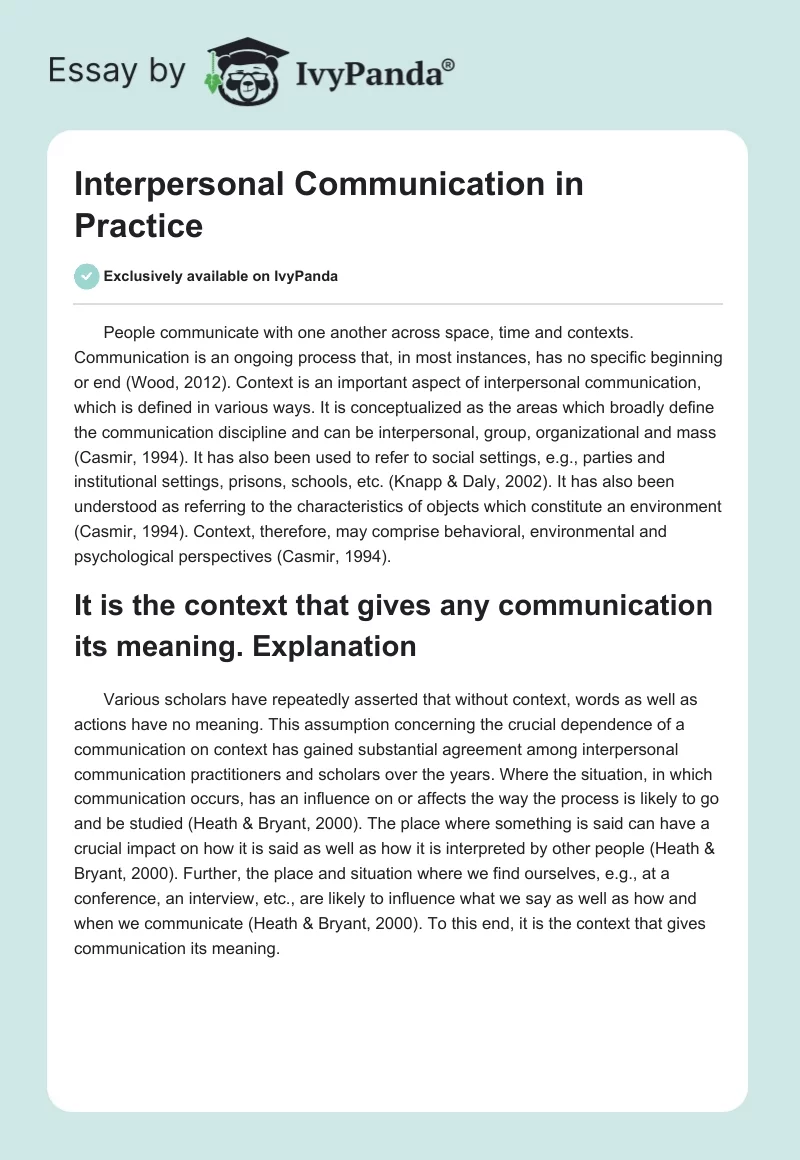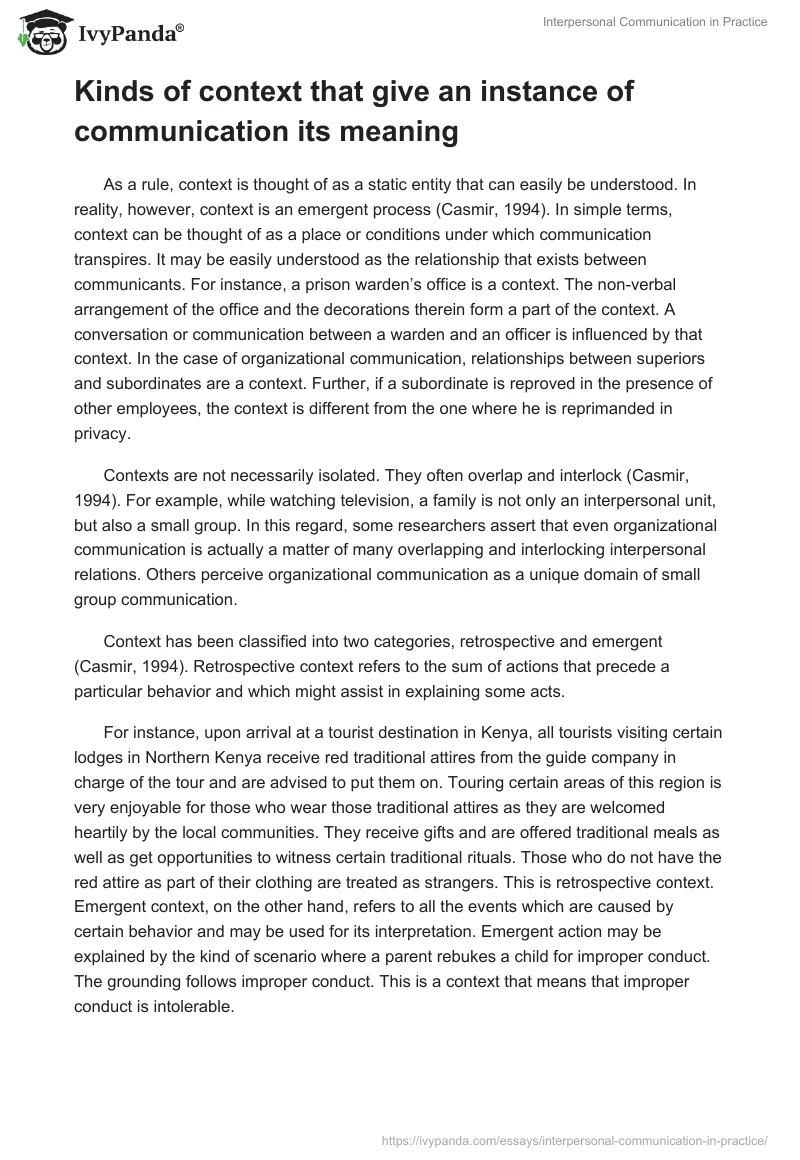People communicate with one another across space, time and contexts. Communication is an ongoing process that, in most instances, has no specific beginning or end (Wood, 2012). Context is an important aspect of interpersonal communication, which is defined in various ways. It is conceptualized as the areas which broadly define the communication discipline and can be interpersonal, group, organizational and mass (Casmir, 1994). It has also been used to refer to social settings, e.g., parties and institutional settings, prisons, schools, etc. (Knapp & Daly, 2002). It has also been understood as referring to the characteristics of objects which constitute an environment (Casmir, 1994). Context, therefore, may comprise behavioral, environmental and psychological perspectives (Casmir, 1994).
It is the context that gives any communication its meaning. Explanation
Various scholars have repeatedly asserted that without context, words as well as actions have no meaning. This assumption concerning the crucial dependence of a communication on context has gained substantial agreement among interpersonal communication practitioners and scholars over the years. Where the situation, in which communication occurs, has an influence on or affects the way the process is likely to go and be studied (Heath & Bryant, 2000). The place where something is said can have a crucial impact on how it is said as well as how it is interpreted by other people (Heath & Bryant, 2000). Further, the place and situation where we find ourselves, e.g., at a conference, an interview, etc., are likely to influence what we say as well as how and when we communicate (Heath & Bryant, 2000). To this end, it is the context that gives communication its meaning.
Kinds of context that give an instance of communication its meaning
As a rule, context is thought of as a static entity that can easily be understood. In reality, however, context is an emergent process (Casmir, 1994). In simple terms, context can be thought of as a place or conditions under which communication transpires. It may be easily understood as the relationship that exists between communicants. For instance, a prison warden’s office is a context. The non-verbal arrangement of the office and the decorations therein form a part of the context. A conversation or communication between a warden and an officer is influenced by that context. In the case of organizational communication, relationships between superiors and subordinates are a context. Further, if a subordinate is reproved in the presence of other employees, the context is different from the one where he is reprimanded in privacy.
Contexts are not necessarily isolated. They often overlap and interlock (Casmir, 1994). For example, while watching television, a family is not only an interpersonal unit, but also a small group. In this regard, some researchers assert that even organizational communication is actually a matter of many overlapping and interlocking interpersonal relations. Others perceive organizational communication as a unique domain of small group communication.
Context has been classified into two categories, retrospective and emergent (Casmir, 1994). Retrospective context refers to the sum of actions that precede a particular behavior and which might assist in explaining some acts.
For instance, upon arrival at a tourist destination in Kenya, all tourists visiting certain lodges in Northern Kenya receive red traditional attires from the guide company in charge of the tour and are advised to put them on. Touring certain areas of this region is very enjoyable for those who wear those traditional attires as they are welcomed heartily by the local communities. They receive gifts and are offered traditional meals as well as get opportunities to witness certain traditional rituals. Those who do not have the red attire as part of their clothing are treated as strangers. This is retrospective context. Emergent context, on the other hand, refers to all the events which are caused by certain behavior and may be used for its interpretation. Emergent action may be explained by the kind of scenario where a parent rebukes a child for improper conduct. The grounding follows improper conduct. This is a context that means that improper conduct is intolerable.
Conclusion
There appears to be the consensus amongst interpersonal communication practitioners and scholars that, indeed, without context, words and actions have no meaning. Context may refer to various things including the environmental setting where words or actions are spoken or done as well as the relationship that exists between the communicants.
This paper has effectively described the meaning of the statement which constitutes the study question. In so doing, it has employed the use of examples to demonstrate context in different scenarios. Further, it has set out a firsthand encounter that denotes context at the instance of cultural difference.
It has set out the different kinds of communication within which context can interlock and overlap. These include interpersonal, group, organizational, mass as well as public types of communication. It has also shown that context is not a static feature as it can either be retrospective or emergent. These two kinds of context have also been discussed and illustrated by setting out the details of the first hand observation.
References
Casmir, F. L. (Ed.). (1994). Building communication theories: A socio/cultural approach. New York, NY: Routledge Publishers.
Heath R. L., & Bryant J. (2000). Human Communication Theory and Research: Concepts, Contextsand Challenges. New York, NY: Routledge Publishers.
Knapp, M. L., & Daly J. A. (Eds.). (2002). Handbook of Interpersonal Communication. New York, NY: Sage Publishers
Wood, J. T. (2012). Interpersonal communication Everyday Encounter. New York, NY: Cengage Learning


